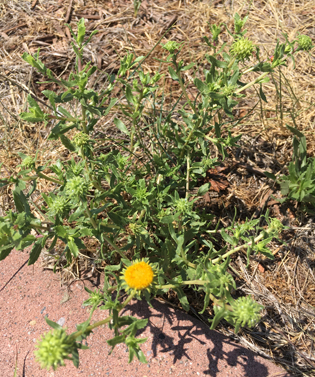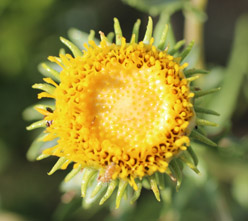
Location
In Visitor Center parking lot (N35D33'00.299 X W105D41'10.188) and
on Convento wall by church (N35D32'59.418 X W105D41'20.819)
Flowers first observed: 7/7/17
Plant w/Flower

The Flower

Distribution
"Found on sands, clays, and subalkaline soils, in disturbed sites, plains, hills, roadsides, along streams, and in forest and woodland understories, from 4,000-8,000 ft (1372-2438 m); flowers July-October Distribution: Widely occurring across the United States." (SEINet)
Description
"Perennial or biennial herbs, occasionally subshrubs, to 1 m tall; stems 1 to several, erect, branching above, usually whitish or stramineous, sometimes reddish or grayish, the herbage gummy-resinous. Leaves: Alternate, the bases clasping the stem; blades oblong to oblanceolate, 3-7 mm long, the margins variously toothed and surfaces stipitate-glandular. Flowers: Flower heads usually radiate, arranged in corymbs or solitary; involucres campanulate, 7-9 mm high, strongly resinous, the bracts (phyllaries) overlapping in 5-6 series, the tips spreading or recurved; rays florets, if present, yellow, 25-40 per flower head, the laminae (ray petals) 7-15 mm long; disk flowers yellow. Fruits: Achenes short, thick, and compressed, 2-3 mm long, whitish, stramineous, brown, or gray; topped with a pappus of 2-3 (-8) straight awns, shorter than the disc corollas." (SEINet)
"The phyllaries are the most distinctive part of the flowerheads of grindelia squarrosa, being thick, green, sticky, evenly spaced, circular in cross-section and (usually) curled back downwards. They are arranged in five or six rows. The all-yellow flowerheads have between 24 and 30 (occasionally fewer; sometimes zero) short ray florets surrounding a large center of disc florets (overall about 3/4 inch in diameter), which become elongated as they mature. The plant produces clusters of many flowerheads, branching towards the top of the stems.
The thick green leaves have small but prominent, regularly spaced teeth along the edges (closer together than the similar grindelia subalpina), and clasp the stems at their base. Stems are hairless, off-white or pale reddish-brown in color. (American Southwest)
Ethnobotanical Uses
Food:
"Some tribes chewed on gumweed leaves or used them fresh or drieed to make an aromatic tea." (Kershaw 186)
Medicine:
"Native peoples and early Jesuit missionaries reognized the medicinal value of this plant. Tea maked from the resinous flowerheads was taken to relieve indigestion, colic and stomachaches. The leaf tea was used to treat throat and lung problems such as coughs, bronchitis and asthma. It was also widely used as a wash to relieve itching and to heal minor cuts and abrasions, pimples and skin irritations (especially rashes caused by poison-ivy ---). A leaf poultice or the gum from pounded flowerheads was applied to poison-ivy inflammations and minor skin problems. Extracts from the dried flower-heads and leaves are said to have sedative, antispasmodic and expectorant qualities. They were once recommended as a treatment for a wide range of ailments, including headaches, malaria, cancers of the spleen and stomach, gonorerhea, pnemonia, rheumatism, smallpox and tuberculosis. More recently, they have been used in medications recommended for treating asthma and bronchitis, and some herbalists recommend them for treating bladder inflammations caused by fungi or food. (Kershaw 186)
Other Uses:
"Plant tops and leaves were used to make washes for healing saddle sores on horses." (Kershaw 186)
Internet Links